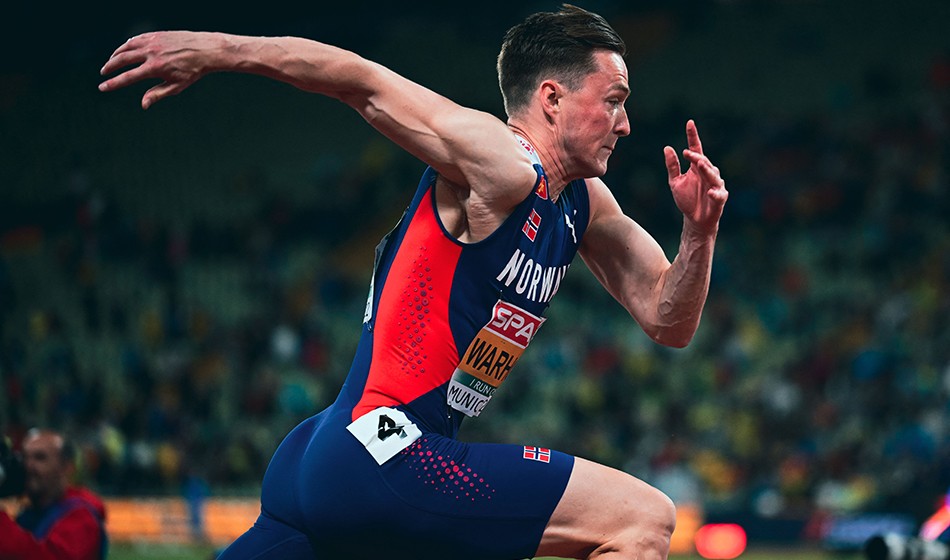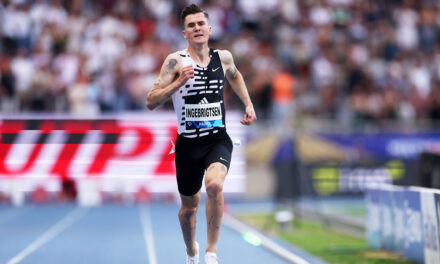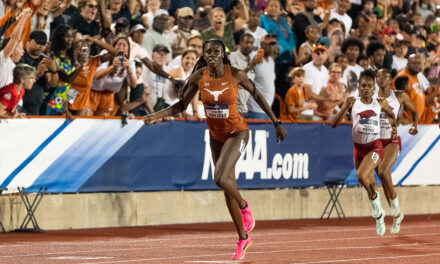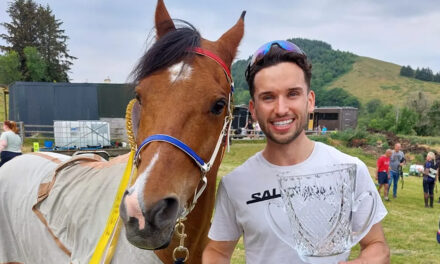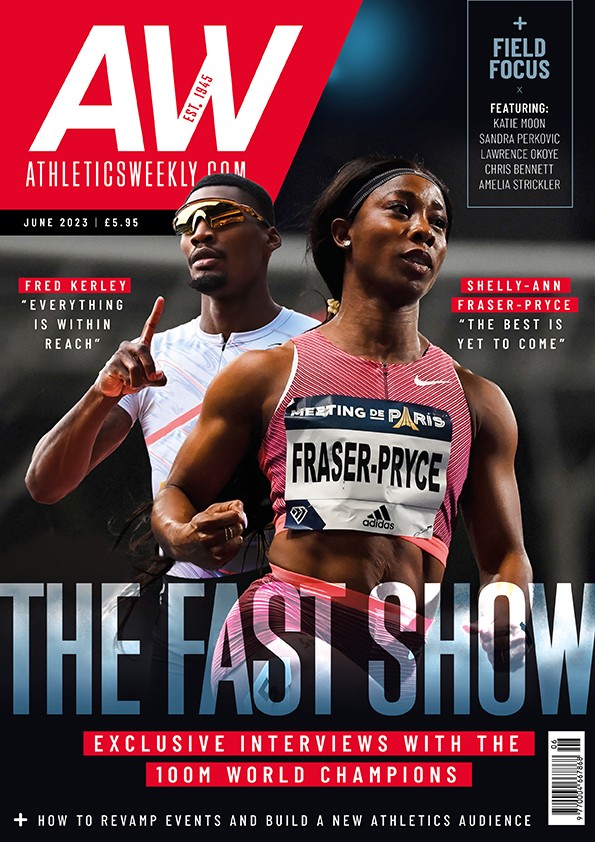Olympic champion and world record-holder at 400m hurdles tells AW he isn’t planning to reduce his power output any time soon
Karsten Warholm won’t die wondering. This is a man completely committed to his cause and it doesn’t need an expert observer to recognise this most elemental of athletes transfers every ounce of his being to the track.
Exhibit A: the 400m final at this year’s European Indoor Championships in Istanbul. The man who is best known for being the 400m hurdles world record-breaking Olympic champion is pretty useful over the flat, too, and was the undoubted favourite to take gold.
He wasn’t about to start playing the percentages, though, and catapulted himself out of the blocks like a man possessed. The first half was covered in a near suicidal 20.84 (an outright 200m PB), with the second lap clocked at a considerably more painful 24.51 as the lactic swept through his body and he tumbled across the line with the competition closing in. When he got to his feet, though, Warholm had finished as the champion.
As athletics writer Cathal Dennehy observed at the time: “Karsten Warholm is the most violent runner I’ve ever seen. It’s like he hates the track with every step.” The athlete in question smiles and has a little laugh to himself at the memory of that final. He knows it wasn’t a race run by the book, but where’s the fun in that?
“The good thing that I take from it is how much I wanted to win that race,” Warholm tells AW from his home in Norway. “I gave it everything and also, in the end, when the lactic hits and you know you’re screwed, that’s a time where you can see me working for it. It shows how much I want this and how motivated I am. I’m not done yet and I don’t feel happy just yet. I like that. My reaction to it is to always fight for the gold medal.”

Karsten Warholm
Warholm is one of the most refreshing athletes to be found on the international circuit. Ask for his opinion on something and he will give it. There’s no skirting around any issue, rather a head-on approach which mirrors his running style. We start with that distinctive, “violent” operating style. It’s a description with which he doesn’t disagree and points to it being the very foundation for his considerable success.
“To be honest, I think there are a lot of athletes around the world that have bigger natural potential than myself,” says the two-time world champion. “I think it’s easy when you see a very gifted, talented runner who has all these things naturally, but me? It’s something I have created over the years with training.
“It’s always been me running because I really want to win, I really want to achieve and it’s all this willpower going into my stride. Yes, I think it’s violent. It’s not something that I do on purpose but that’s the way I get out my speed and I think, from the first step, for me it’s a battle to win.
“When the gun goes, there are no jokes for me anymore. This is all the hours that I put in.
“I just run with a lot of aggression, but it works well for me.”
It is indeed an important point to make that such a relentlessly forceful template would not work for most athletes, yet for Warholm it does come with some important benefits.
“A lot of athletes have tried my spike, but they can’t bend the [carbon] plate [within the shoe] – it’s the way I’m pushing with every step. That’s why I can have probably the stiffest carbon plate in the game, because there’s so much power in each step.
“It doesn’t always look technically out of the schoolbook but it’s the way that I run the fastest and I don’t want to change that.”
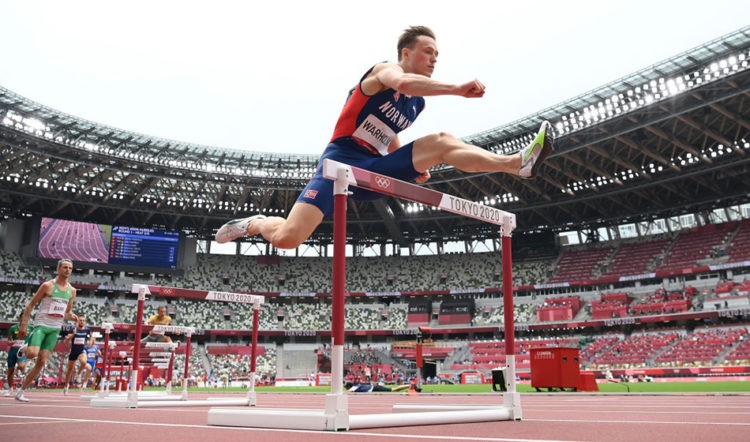
Karsten Warholm (Getty)
And with that we veer towards the next subject, which can be a touchy one in athletics circles: footwear. Some distance athletes have become increasingly willing to discuss the role being played by the rapid advances in shoe technology on the roads, but that is not necessarily a situation being replicated by track competitors when it comes to their spikes.
Warholm, again, is an exception. He made headlines in the aftermath of his extraordinary Tokyo gold medal-winning run by calling Nike’s super spikes “bull***t” at a time when the American super brand were still very clear leaders in the technological race.
The landscape has shifted, though, and Warholm has worked very closely with sponsors Puma to develop his current competition footwear. He now sees the battle between the brands as a positive step for the sport.
He isn’t about to pretend the tools of his trade don’t make a difference, though, and there’s a reminder of his willingness to poke fun at himself, too, given that his Naio Nitro Elite spikes are adorned by a logo which reads #BS.
“I think I’m the only athlete that’s actually been honest about what shoes bring to the game but it’s a game changer for sure. But now I have the best shoe so I don’t care,” he grins.
“I was really stressed about this before going to Tokyo because you saw all of these prototypes coming up and nobody had control. The athletes didn’t have control, a lot of brands weren’t on top of it and I even think that it came as a surprise to Word Athletics.
“Now it’s open. Puma has given me great opportunities to make a shoe. I find it very interesting and I like to work with it but I will never say that the shoe doesn’t matter anymore because we are already past that point.
“How much does it matter? I don’t know and I think it’s very individual. Some shoes work on some people, some shoes don’t work on others. I have a very stiff plate and if I can bend that plate I’ll get a lot of energy out of it – that’s how the physics works – but if you were in my shoe you would probably just pull your Achilles or your calf and you wouldn’t get anything out of it.”
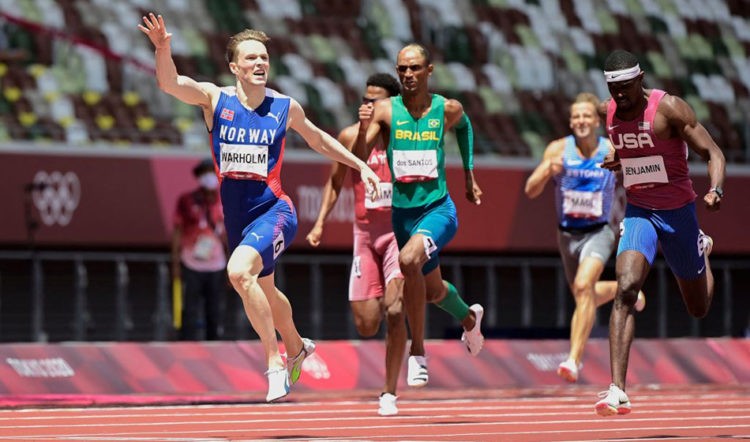
Karsten Warholm, Rai Benjamin and Alison dos Santos (Getty)
He continues: “In the beginning, I was just p****d because I didn’t have the shoes! But now every brand has had a couple of years to get into it and I think it’s good for the sport that a lot of brands find this as a competition between themselves.
“I won’t say that everything is bad. I’m just saying let’s not live in denial.”
Warholm would also like to see a change in attitude when it comes to the next subject of our conversation. There is a recurring discussion in elite athletics about getting more exposure and money for the sport and its top names, that those at the very sharp end are hard done by in comparison with other sports.
The two-time European champion can understand the grumbles of discontent but insists the best way for athletes to change the situation is to work on doing something about it themselves.
“I don’t think our sport is in as such bad shape as some people say and I also think that, whenever people are complaining, it doesn’t make the sport more sexy, does it?” he says. “Whenever somebody complains: ‘Oh people aren’t giving me money’ do you think somebody will just come with a big bag of money and give it to you?
“You’ve got to step up and show what you can bring to the table and I think there’s a lot of great personality in the sport right now and there are a lot of cool meetings. The Diamond Leagues go to a lot of cool places, the World Championships are popular and whenever there’s track and field in the Olympics it’s sold out.
“If there’s one thing I would stop doing it’s complaining. If we stop complaining and start doing something about it, we actually have a chance. It needs to be an interesting product.”
View this post on Instagram
He cites his own event as a prime example. It’s not so long ago, Warholm says, that the 400m hurdles was being considered as one of the events to be dropped from the Diamond League circuit when there was a reshuffle of the disciplines back in 2019. However, his exploits, not to mention those of women’s world record-holder Sydney McLaughlin-Levrone and Dutch star Femke Bol, have turned hurdling into a marquee event once more.
“The 400m hurdles was in that [Diamond League] discussion and now they wouldn’t throw it out for anything,” adds Warholm. “That just shows that interest is created and it’s not going to be a constant and I think we need to bring that with us and create interesting projects.”
» This is an excerpt from an interview that appeared in the May issue of AW, which you can read here

